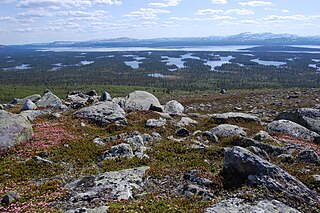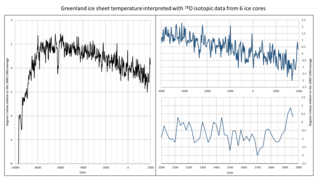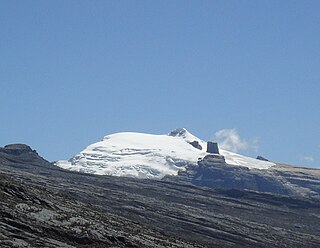
A loess is a clastic, predominantly silt-sized sediment that is formed by the accumulation of wind-blown dust. Ten percent of Earth's land area is covered by loesses or similar deposits.

The Last Glacial Period (LGP), also known colloquially as the Last Ice Age or simply Ice Age, occurred from the end of the Last Interglacial to the end of the Younger Dryas, encompassing the period c. 115,000 – c. 11,700 years ago.

The Glaciated Allegheny Plateau is that portion of the Allegheny Plateau that lies within the area covered by the last glaciation. As a result, this area of the Allegheny Plateau has lower relief and gentler slopes than the relatively rugged Unglaciated Allegheny Plateau. In general, the glaciated lies to the north and west of the unglaciated, and forms an arc in northeastern to southeastern Ohio lying between the glacial till plains and the Unglaciated Allegheny Plateau. The Glaciated Allegheny Plateau extends into a belt of southern New York State and the central Susquehanna River basin.
Proceedings of the Royal Society is the main research journal of the Royal Society. The journal began in 1831 and was split into two series in 1905:
The Kansan glaciation or Kansan glacial was a glacial stage and part of an early conceptual climatic and chronological framework composed of four glacial and interglacial stages.
The Yarmouthian stage and the Yarmouth Interglacial were part of a now obsolete geologic timescale of the early Quaternary of North America.

The Journal of Biological Chemistry (JBC) is a weekly peer-reviewed scientific journal that was established in 1905. Since 1925, it is published by the American Society for Biochemistry and Molecular Biology. It covers research in areas of biochemistry and molecular biology. The editor is Alex Toker. As of January 2021, the journal is fully open access. In press articles are available free on its website immediately after acceptance.

A Rogen moraine is a subglacially formed type of moraine landform, that mainly occurs in Fennoscandia, Scotland, Ireland and Canada. It is one of the three main types of hummocky moraines. They cover large areas that have been covered by ice, and occur mostly in what is believed to have been the central areas of the ice sheets. Rogen moraines are named after Lake Rogen in Härjedalen, Sweden, the landform's type locality. Rogen Nature Reserve serves to protect the unusual area.
The Journal of Quaternary Science is a peer-reviewed academic journal published on behalf of the Quaternary Research Association. It covers research on any aspect of quaternary science. The journal publishes predominantly research articles with two thematic issues published annually, although discussions and letters are occasionally published along with invited reviews. According to the Journal Citation Reports, the journal has a 2012 impact factor of 2.939.

The neoglaciation describes the documented cooling trend in the Earth's climate during the Holocene, following the retreat of the Wisconsin glaciation, the most recent glacial period. Neoglaciation has followed the hypsithermal or Holocene Climatic Optimum, the warmest point in the Earth's climate during the current interglacial stage, excluding the global warming-induced temperature increase starting in the 20th century. The neoglaciation has no well-marked universal beginning: local conditions and ecological inertia affected the onset of detectably cooler conditions.
Quaternary science is the subfield of geology which studies the Quaternary Period commonly known as the ice age. The Quaternary Period is a time period that started around 2.58 million years ago and continues today. This period is divided into two epochs – the Pleistocene Epoch and the Holocene Epoch. The aim of Quaternary science is to understand everything that happened during the Pleistocene Epoch and the Holocene Epoch to be able to acquire fundamental knowledge about Earth's environment, ecosystem, climate changes, etc. Quaternary science was first studied during the nineteenth century by Georges Cuvier, a French scientist. Most Quaternary scientists have studied the history of the Quaternary to predict future changes in climate.

The Sierra Nevada del Cocuy Chita or Guican National Natural Park (or Sierra Nevada de Chita or Sierra Nevada de Güicán, Spanish: Parque Natural Sierra Nevada del Cocuy Chita o Guican is a national park and a series of highlands and glaciated peaks located within the Cordillera Oriental mountain range in the Andes Mountains of Colombia, at its easternmost point. It also corresponds to the highest range of the Eastern Cordillera and holds the biggest glacial mass in South America, north of the Equator. Since 1977, this region is protected within a National Natural Park because of its fragile páramos, extraordinary bio-diversity and endemism, and its function as a corridor for migratory species under conditions of climate change. Among the Sierra’s natural attractions are the remaining 18 ice-covered peaks, glacial lakes and waterfalls.
Acta Paediatrica is a monthly peer-reviewed medical journal covering paediatrics. It is published by Wiley-Blackwell on behalf of the Foundation Acta Paediatrica, based at the Karolinska Institute in Sweden.
Quaternary Environment of the Eurasian North, abbreviated QUEEN was an international and interdisciplinary research programme in the Arctic.
The Journal of the Marine Biological Association of the United Kingdom is a peer-reviewed scientific journal that was established in August 1887. Originally set up to provide members of the Marine Biological Association of the United Kingdom with "notes and reports concerning the work of the Association" along with "brief records of observations relating to the marine biology and fisheries of the coasts of the United Kingdom". Since 1937 the journal has been published by Cambridge University Press on behalf of the association. According to the Journal Citation Reports, the journal has a 2017 impact factor of 1.403.
A buried valley is an ancient river or stream valley that has been filled with glacial or unconsolidated sediment. This sediment is made up of predominantly gravel and sand, with some silt and clay. These types of sediments can often store and transmit large amounts of groundwater and act as a local aquifer.
BIOSIS Previews is an English-language, bibliographic database service, with abstracts and citation indexing. It is part of Clarivate Analytics Web of Science suite. BIOSIS Previews indexes data from 1926 to the present.
Quaternary International is a peer-reviewed scientific journal on quaternary science published by Elsevier on behalf of the International Union for Quaternary Research. The journal was established in 1989 and covers full spectrum of the physical and natural sciences that are commonly employed in solving problems related to the quaternary period. The editor-in-chief is Min-Te Chen.
Quaternary Science Reviews is a peer-reviewed scientific journal covering quaternary science. It was established in 1982 by Pergamon Press and is currently published by Elsevier. The editor-in-chief is C.V. Murray Wallace. According to the Journal Citation Reports, the journal has a 2013 impact factor of 4.571.







